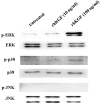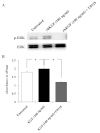Keratinocyte growth factor stimulates growth of MIA PaCa-2 cells through extracellular signal-regulated kinase phosphorylation
- PMID: 22740901
- PMCID: PMC3362380
- DOI: 10.3892/ol.2011.466
Keratinocyte growth factor stimulates growth of MIA PaCa-2 cells through extracellular signal-regulated kinase phosphorylation
Abstract
Keratinocyte growth factor (KGF), also known as fibroblast growth factor-7, is mainly synthesized by mesenchymal cells. KGF modulates proliferation, differentiation, migration and adhesion to extracellular matrices of epithelial cells that specifically express the KGF receptor (KGFR). We previously reported that KGF is expressed in cancer cells and adjacent stromal fibroblasts in human pancreatic cancer tissues. Furthermore, KGF is thought to stimulate the growth of certain pancreatic cancer cell lines. The aim of the present study was to examine whether the mitogen-activated protein kinase (MAPK) pathway contributes to exogenous KGF-induced pancreatic cancer cell growth. Recombinant human KGF (rhKGF) was administered to MIA PaCa-2 cells, which expressed KGFR and negligible levels of KGF. Cell growth rates in MIA PaCa-2 cells were significantly increased in a dose-dependent manner following the addition of rhKGF. In the MAPK pathway, phosphorylation of extracellular signal-regulated kinase (ERK) in MIA PaCa-2 cells was increased in a dose-dependent manner, and phosphorylation of p38 was slightly increased following the administration of 100 ng/ml rhKGF. In contrast, JNK was not phosphorylated following the addition of rhKGF in MIA PaCa-2 cells. U0126, a specific inhibitor of ERK activation, decreased the rhKGF-induced phosphorylation of ERK and the growth rates of MIA PaCa-2 cells. These findings indicated that phosphorylation of the ERK signaling pathway plays a significant role in exogenous KGF-induced pancreatic cancer cell growth.
Figures



Similar articles
-
Enhanced expression of keratinocyte growth factor and its receptor correlates with venous invasion in pancreatic cancer.Am J Pathol. 2007 Jun;170(6):1964-74. doi: 10.2353/ajpath.2007.060935. Am J Pathol. 2007. PMID: 17525264 Free PMC article.
-
Nerve growth factor exerts differential effects on the growth of human pancreatic cancer cells.Clin Cancer Res. 2001 Jan;7(1):105-12. Clin Cancer Res. 2001. PMID: 11205897
-
Activation of mitogen-activated protein kinase pathway by keratinocyte growth factor or fibroblast growth factor-10 promotes cell proliferation in human endometrial carcinoma cells.J Clin Endocrinol Metab. 2003 Feb;88(2):773-80. doi: 10.1210/jc.2002-021062. J Clin Endocrinol Metab. 2003. PMID: 12574212
-
Keratinocyte growth factor induces vascular endothelial growth factor-A expression in colorectal cancer cells.Int J Oncol. 2009 Feb;34(2):355-60. Int J Oncol. 2009. PMID: 19148469
-
Keratinocyte growth factor as a cytokine that mediates mesenchymal-epithelial interaction.EXS. 1995;74:191-214. doi: 10.1007/978-3-0348-9070-0_10. EXS. 1995. PMID: 8527895 Review.
Cited by
-
Engineered Resistant-Starch (ERS) Diet Shapes Colon Microbiota Profile in Parallel with the Retardation of Tumor Growth in In Vitro and In Vivo Pancreatic Cancer Models.Nutrients. 2017 Mar 27;9(4):331. doi: 10.3390/nu9040331. Nutrients. 2017. PMID: 28346394 Free PMC article.
-
Keratinocyte Growth Factor Reduces Injury and Leads to Early Recovery from Cyclophosphamide Bladder Injury.Am J Pathol. 2020 Jan;190(1):108-124. doi: 10.1016/j.ajpath.2019.09.015. Epub 2019 Oct 22. Am J Pathol. 2020. PMID: 31654636 Free PMC article.
References
-
- Finch PW, Rubin JS, Miki T, Ron D, Aaronson SA. Human KGF is FGF-related with properties of a paracrine effector of epithelial cell growth. Science. 1989;245:752–755. - PubMed
-
- Brauchle M, Angermeyer K, Hubner G, Werner S. Large induction of keratinocyte growth factor expression by serum growth factors and pro-inflammatory cytokines in cultured fibroblasts. Oncogene. 1994;9:3199–3204. - PubMed
-
- Katoh M. Cancer genomics and genetics of FGFR2 (Review) Int J Oncol. 2008;33:233–237. - PubMed
-
- Ornitz DM, Xu J, Colvin JS, et al. Receptor specificity of the fibroblast growth factor family. J Biol Chem. 1996;271:15292–15297. - PubMed
LinkOut - more resources
Full Text Sources
Other Literature Sources
Research Materials
Miscellaneous
